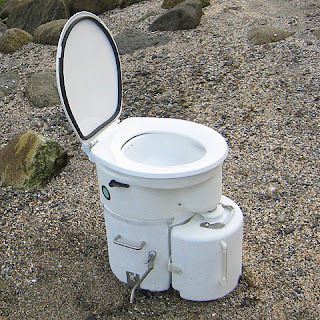Overall our experience with the Airhead has been very good. We used the boat 1-3 days per week throughout the summer, averaging four people onboard. We also had a full 6 day cruise with the family, in the middle of the summer, that was a true test of the system.
Using the Airhead
We have had almost no issues with using the Airhead. We do make sure to take a couple of minutes to orient guests on how to properly use the system but, really, it is dumb simple.The only use problem that we did have was with a younger child who insisted on opening the solid flap when it was a liquid job, if you know what I mean. That resulted in a smelly slurry being formed in the solid bin after a weekend of misuse. Adding extra peat moss solved the issue fairly quickly (a couple of days).
Cleanliness
We had no cleanliness issues. A quick wipe down on occasion and a spray bottle of water for occasional use kept the unit very clean.Emptying the unit
I found that we had to empty the liquid tank approximately every 1 1/2 days with 4 people on the boat. This varied a bit depending on the amount of beer being consumed! Emptying the liquid tank is quick and easy. Don't wait for it to get full in the middle of the night though!We did have to empty the unit near the end of August. I'm guessing that we could have gotten through the rest of the summer had we not had the above-mentioned 'slurry episode'. The extra peat moss added a lot of volume. Regardless, emptying the unit, was straight forward and no more difficult or unpleasant than a single pump-out would be in a standard holding tank setup. We emptied the contents into a doubled compostable garbage bag. We've set the bag behind our garden to give it some time over winter to fully compost.
Issues
There weren't many issues but there were a few:- Exhaust fan - The exhaust has stopped working 3 times throughout the summer. I simply had to take the vent housing apart and give the fan a little turn manually and it would start spinning again. I presume that there was little bits of dust that were clogging the fan. Perhaps a stronger fan motor would be in order. (Update [10/8/2012]: This part is under warranty and will be replaced by Airhead)
- Liquid level indicator - There is a little clear tube that shows the level of liquid in the tank. It regularly gets clogged by small bits of crud that end up in that tank through normal use. Don't rely on the little tube to tell you the bottle is full!
- Agitator - The agitator inside the solid tank doesn't always stir the full contents of the unit. This only became apparent as I tried to add peat moss to fix my slurry issue. Not usually an issue.
Conclusion
I would recommend an Airhead to other boats (I regularly do!). It certainly beats our old holding tank system. It is easy to maintain and use. It is also a good conversation piece!
If you have any specific questions or comments about our experience with the unit (or anything else), please comment below.





















